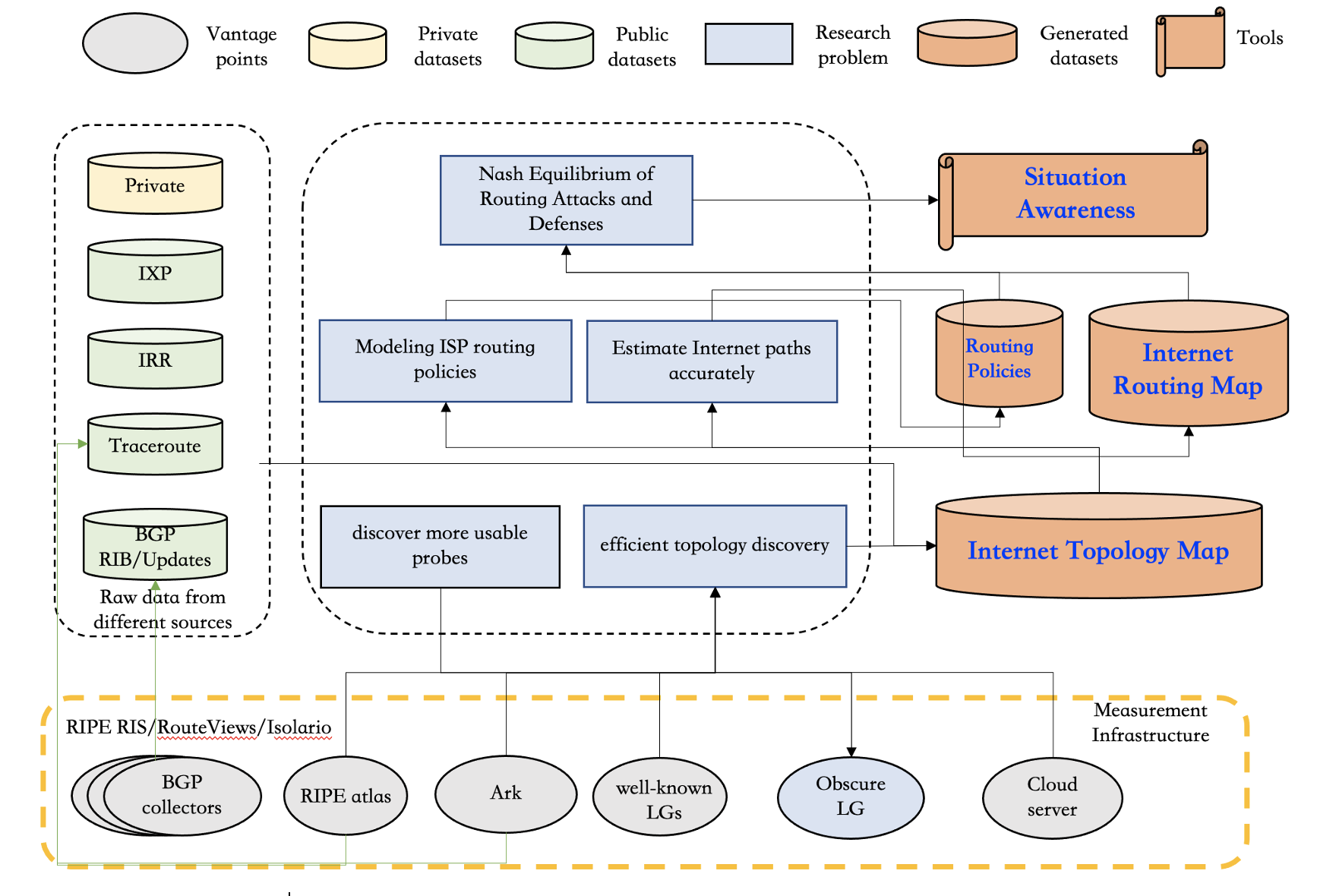
Understanding and Evaluating the Internet Routing
The Internet has been extremely important for everyone. However, as a large-scale distributed system without centralized authoritative control, the Internet is so complicated that people cannot accurately map its topology and routing, not to mention understanding and predicting its reactions to various changes potentially conducted by differnt parties in the Internet. Basically, I am curious about the following questions:
1) Can we have a (more) complete and accurate AS-level Internet topology? How far are we from a complete and accurate AS-level Internet map?
2) Which nodes/links are crucial in the Internet map? Definitely the cruciality/significance of a node/link would be different for different parties and in different scenarios.
3) Can we have a (more) accurate AS-level Internet routing map? We would like to know the exact path between any two end nodes in the Internet.
4) Assuming we have had a good Internet routing map, can we predict the Nash Equilibrium of a game in which two players in the Internet try to control routing paths using any techinical or business approaches?

About the Ongoing NSFC Project
There has been evidence that some nations have deployed surveillance systems on core Internet transit links that reside within their borders, which means international traffic flows of other nations which traverse these links to reach their destinations are under the security risk of being analyzed. Definitely this kind of cases will be more prevalent in the future. Therefore, it is very important to investigate the following questions.
1) In the current Internet routing, how significant is the exposure of its own international traffic flows by routing infrastructure to other nations? Can this nation make all its international traffic flows routing around its adversary nations successfully?
2) When the international situation becomes tense, every nation will try its best to revise the Internet routing decisions via any techniques and strategies. The final routing of traffic flows is determined by all participants, which means the actions of these nations are interacted with each other. When every nation cannot improve its situation by revising its own actions, a stable Internet would be reached. It is valuable to know the situation of each nation in the routing of the stable Internet.
We believe the research efforts of this project will promote research progress of Internet topology and routing inference, and have high significance for understanding and improving the routing security of traffic flows of our nation.
Previous Works in This Area
My PhD thesis is on interdomain traffic engineering and ISPs’ peering strategies, which is related to Interdomain routing and Internet economics. At that time, P2P traffic was very popular in the Internet which made influence on ISPs’ peering practices. With P2P applications, ISPs with more subscribers tend to become content providers for small ISPs, which is a kind of unfairness for larger ISPs, and then large ISPs are more likely to de-peer with small ISPs than before. We noticed this tussle betweeen overlay routing and underlay routing and developed a two-stage multi-leader-follower game (stackelberg game) to explain and predict the impact of this kind of tussles. It is really an interesting topic and I realized that the Internet is driven by both technical and economic factors. It motivated some of my later works. I studied the evolution of the interdomain (AS-level) Internet topology in 2012, and reported the phenomenon that the boundaries between neighboring layers in the Internet core were more and more blurred while the Internet edge still had a distinct hierarchical characteristic. The other difference between Internet core and Internet edge is that link births/deaths in the Internet core follow the “Preferential Attachment/de-attachment” rule, while link births/deaths in the Internet edge follow a super linear preferential attachment/de-attachement rule. With the growing number of potential transit provider and the flattening topology of the Internet, it was getting harder for ISPs to select upstream providers empirically as before. In 2014, I proposed a concept of bargaining power as an important decision-making criterion of ISPs during their provider selection process, and designed a shapley-value-based framework to help ISPs' provider selection based on it. I got support from the Natural Science Foundation of China for these works in 2012 (NSFC 61202356).
In 2016, I started to concern about geographical properties of Internet routing. I noticed the phenomenon of routing detours, which raises concerns both on network security of nations and efficiency of resource consumption. To some extent, geo-optimal routing can be viewed as a long-term goal of Internet routing, and a careful designed Internet together with geo-optimal routing can produce the best performance for the Internet. I analyzed the Internet routing, reported some intercontinental circuitousness cases, and summarized the possible reasons of routing detours based on these cases. In 2018, I conducted a study to further understand two geographic properties of Internet routing: geographically routing circuitousness of paths and geographically routing centrality of countries and continents. It shows that the routing circuitousness of our Internet is deteriorating in these years. Our temporal analysis on the routing dependence among countries and continents finds out the importance of Europe was decreasing comparing with its competitor North America in the past years, and a few countries are in fact controlling most Internet inter-nation traffic flows.
In recent two years, it becomes more evident the forces that drive the evolution of the Internet are not only technology and business considerations, but also politics among nations. In 2020, I got support from the Natural Science Foundation of China to study the risk of Inter-Nation surveillance and the evasion game in the Internet Routing. In this project, I aim to build a more complete and accurate AS-level Internet map, estimate interdomain paths for all source-destination pairs and geolocate these paths, so we can understand the risk of being surveilled by other countries. When the international situation becomes tense, every nation will try its best to revise the Internet routing decisions via any techniques and strategies, and the final routing of traffic flows is determined by all participants. I am trying to use game theory to understand the situation of each nation in the routing of the stable Internet. As the first step, I am trying to get a better “battlefield map”. We develop an algorithm to find as many looking glass servers (both well-known and obscure) as possible and also develop an automation tool to use these servers systematically and automatically for measurement tasks. This work got accepted by CoNEXT 2021 recently. One reviewer commented “it is my new favorite paper” and most reviewers urged us to publish our tool and the list of LG pages we found because the tools and list are thought to be very useful for their works. The tools and the list have been publicly accessible now.
The research works mentioned on this page are mainly focused on Internet-related issues, including Internet measurement and network management. The other research direction of mine is various network systems, which is introduced here.
Details of Some Publications
| [CoNEXT 2021] |  Shuying Zhuang, Jessie Hui Wang, Jilong Wang, Zujiang Pan, Tianhao Wu, Fenghua Li, and Zhiyong Zhang, "Discovering Obscure Looking Glass Sites on the Web to Facilitate Internet Measurement Research," CoNEXT 2021, Munich, Germany (Virtual Conference), December 7-10, 2021. doi: (to appear.) paper Despite researchers have noticed that Looking Glass (LG) vantage points (VPs) are valuable for Internet measurement researches, they can only exploit VPs from well-known LG sites published on several LG portal pages. There should be a lot of LG sites that are not published in these portal pages, namely obscure LG sites, which are not easy to be found and exploited by researchers. In this paper, we design an efficient focused crawler to discover as many LG sites as possible which can avoid unnecessary resource consumption on analyzing irrelevant pages. To facilitate practical applications, we further develop an automation tool, which can successfully retrieve 910 obscure automatable LG VPs from relevant pages obtained through our focused crawler. The 910 LG VPs significantly increase the geographic and network coverage of available VPs and we show their potential values in improving the completeness of AS-level Internet topology by a simple case study. Our method and the final VP list (which will be publicly accessible) are beneficial to the measurement community. One reviewer commented “it is my new favorite paper” and most reviewers urged us to publish our tool and the list of LG pages we found because the tools and list can be very useful for their research. We make all artifacts of this paper available at Github, including source codes, tools developed by us, and the final list of 1,446 known automatable VPs and 910 obscure automatable VPs found by us. |
| [CN 2020] | 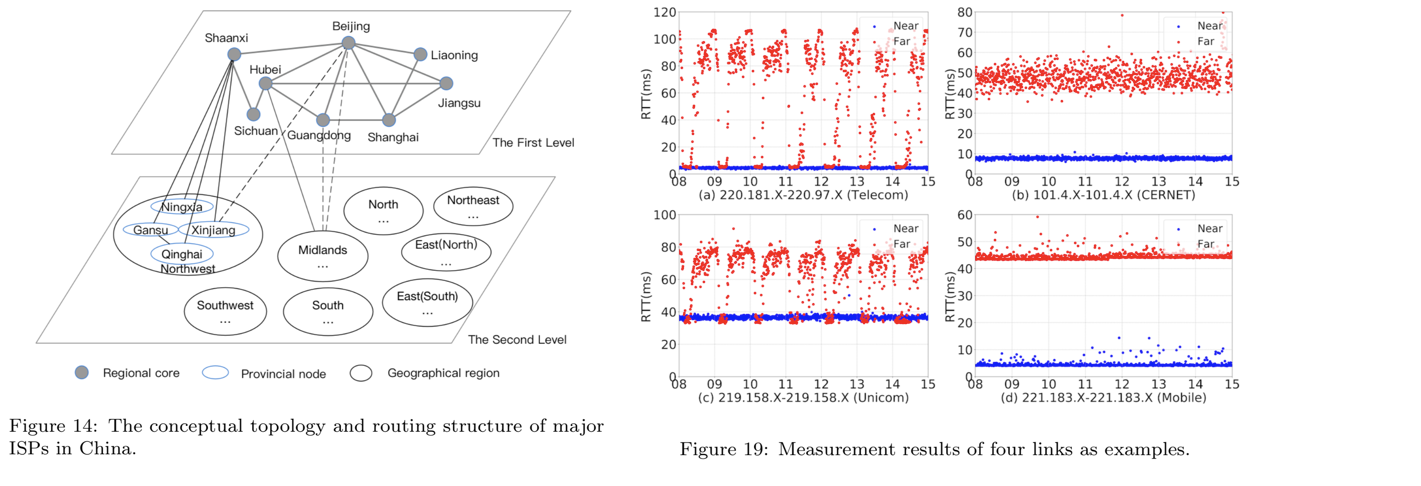
Shuying Zhuang, Jessie Hui Wang, Pei Zhang , Jilong Wang , "Understanding the latency to visit websites in China: an infrastructure perspective," CN 2020, Volume 169, 14 March 2020. paper As the Internet becomes more and more widely used in our daily life, its latency has been regarded as a truly critical issue for various Internet applications. Researchers propose an ambitious goal to pursue “Speed-of-Light Internet”. However, there is a large gap between the reality and the goal, and a lot of infrastructure inefficiency caused by simple issues has been observed in some developing or rural regions. In this article, we conduct a measurement study on the latency to visit more than 638K websites in China from five well-connected vantage points, and examine the unnecessary latency caused by the inefficiency of DNS infrastructure and Internet routing infrastructure in China. We find that DNS resolution is the most significant contributor to the overall latency and investigate several important factors that affect DNS latency, i.e., caching, CNAME and delegation. In terms of Internet routing infrastructure in China, we observe that 1) the inter-domain routing in China relies too heavily on the three oldest IXPs while the newly deployed IXPs are under-used significantly, which results in unnecessary routing circuitousness; and 2) most congested links are the links connecting cities with IXPs and these links should be upgraded or utilized with more efficient traffic engineering systems. Furthermore, in order to compute circuitousness ratios and locate congested links, we also propose a method to geolocate IP addresses in China more accurately and we make the geolocation results for IP addresses under the study of this work publicly accessible to facilitate future research efforts. |
| [IWQoS 2019] | 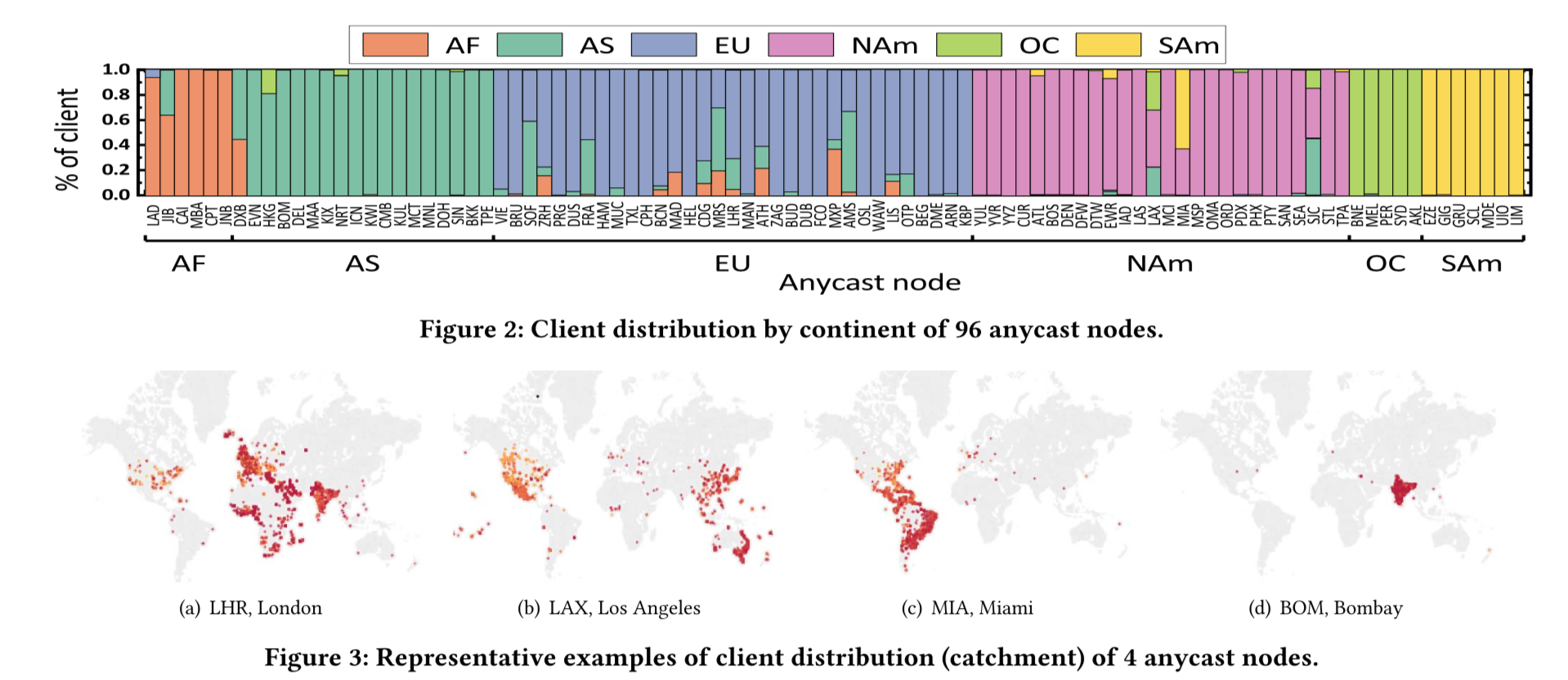
JingAn Xue, Weizhen Dang, Haibo Wang, Jilong Wang, Jessie Hui Wang, "Evaluating Performance and Inefficient Routing of an Anycast CDN," IWQoS 2019. paper Anycast has been increasingly deployed for content delivery networks to map clients to their nearby replicas, which relies on the underlying routing. However, the simplicity of operation comes at cost of less precise client-mapping control. Although many works have measured anycast DNS, anycast CDNs, with different service goals and engineering, are still not fully understood. In this paper, we design novel methods and combine large-scale traceroute and HTTP measurement to evaluate the overall client-proximity and inefficient routing of the largest anycast CDN, Cloudflare. We find that 90% paths traverse only 2-4 ASes, which highlights its direct networks providers. By further identifying and characterizing direct providers at finer granularity of facilities, we quantitatively shows that Cloudflare unevenly uses few large transit providers to delivery the majority of contents. Inspired by the observations, we propose an anycast routing pathology and diagnosis methodology. Investigation reveals that few huge providers have outsized impact in that they are not only related to many inter-domain inflations, but also have path inflation inside their own networks, thus deserving priority focus when troubleshooting. |
| [CN 2018] | 
Jessie Hui Wang, Changqing An, "A Study on Geographic Properties of Internet Routing," CN 2018, vol. 133, pp. 183-194, 2018. paper In order to make a better control over the routing of Internet traffic, more and more researchers and governments want to understand how international reachability depends on individual countries. It has been necessary and valuable for us to study the geographic properties of Internet routing. In this paper, we conduct a measurement study on the dataset from 2011 to 2015 to understand two geographic properties of Internet routing: geographically routing circuitousness of paths and geographically routing centrality of countries and continents. Our analysis shows that the routing circuitousness of our Internet is deteriorating in these years. We also find that United States, Great British, France and Germany have most control over the data transfer in the Internet, but their farness centrality indexes are not smallest. Furthermore, our temporal analysis on the routing dependence among countries and continents finds out the importance of Europe was decreasing comparing with its competitor North America in the past years. |
| [ICOIN 2016] | 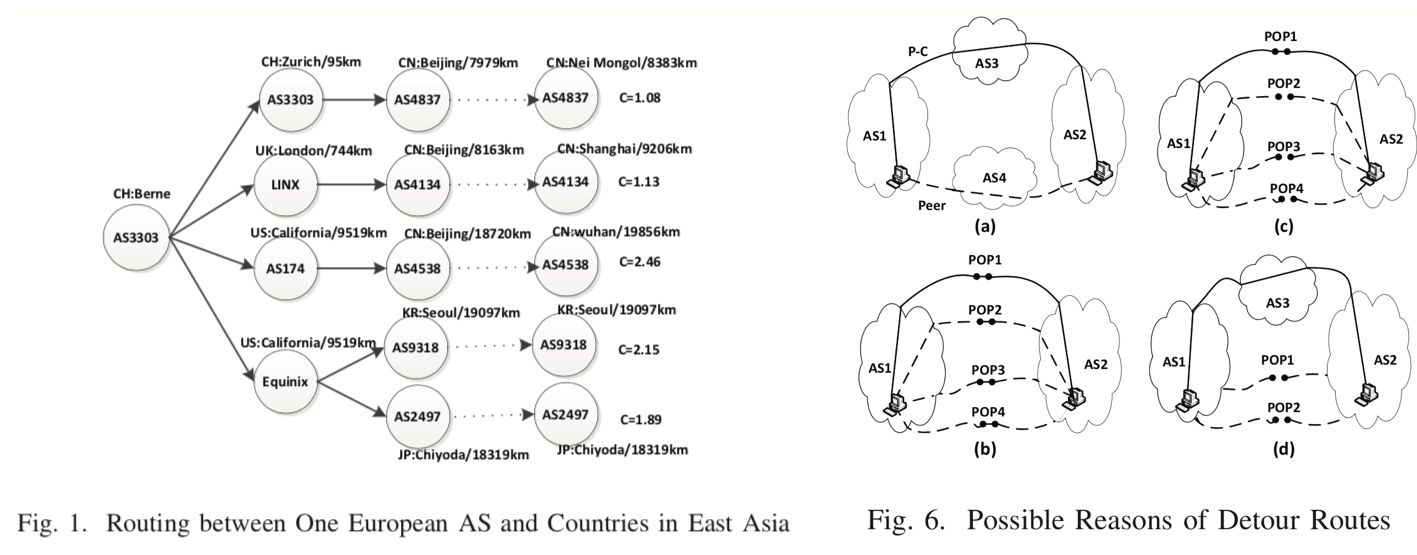
Pengcheng Du, Hui Wang, Jiahai Yang, Jianfeng Wang, and Youjian Zhao, "Analyzing Intercontinental Circuitousness to Improve the Interconnection and Routing for ISPs," ICOIN 2016, Malaysia, Kota Kinabalu, January 13-15, 2016. paper Routing detours raise concerns both on network security of nations and efficiency of resource consumption. Geo-optimal routing can be viewed as a long term goal of Internet routing, and a careful designed Internet together with geo-optimal routing can produce the best performance for the Internet. In this paper, we focus on some representative intercontinental circuitous paths summarized from our measurement data set. With the help of PeerDB and CAIDA, we try to find possible reasons for the detour routing and propose some suggestions to improve interconnection and routing for ISPs. |
| [NOMS 2014] | 
Miao Li, Hui Wang, Jiahai Yang, Chenxi Li," A Value Based Framework for Provider Selection of Regional ISPs," NOMS 2014,May 5-9 2014, Krakow, Poland. paper To access to the Internet, regional Internet Service Providers (ISPs) have to buy transit service from global ISPs. Provider selection strategies are related closely to ISPs` economic interests. With the growing number of potential transit provider and the flattening topology of the Internet, it’s getting harder for ISPs to select upstream provider empirically as before. In this paper, we propose a concept of bargaining power as an important decision-making criterion of ISPs during their provider selection process, and design a value based framework to help ISPs’ provider selection based on it. The bargaining power of each involved ISP is computed by applying the Shapley Value based transit value distribution mechanism to each involved traffic flow, taking into consideration the cooperative possibility among ISPs and the market roles these ISPs play, i.e., potential providers or potential competitors. It reflects not only the cost and link level transit performance, geographical constraints, but also includes the influence of interconnection impacts, demand/supply relationships by analyzing the traffic content and commercial relationships among ISPs. We then design a quantitative provider selection framework and instantiate our framework using the operation data of a real-world network, CERNET, a national ISP in China. In addition, we evaluate our provider selection results for CERNET and the experimental results show the effectiveness and practicability of our solution in this paper. |
| [APNOMS 2012] | 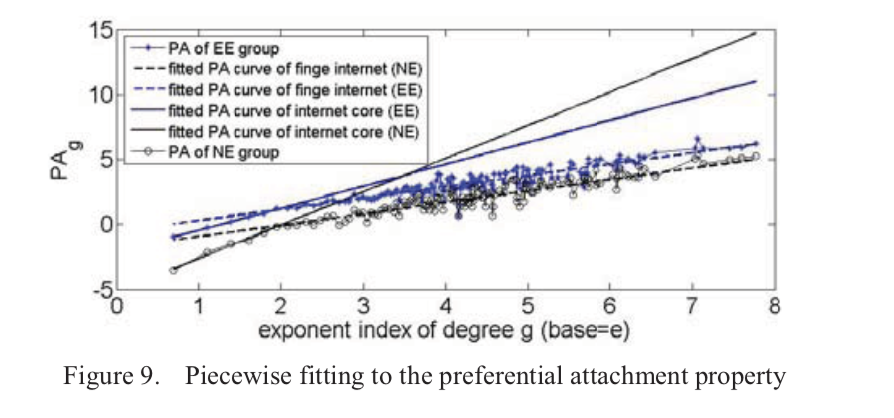
Miao Li, Hui Wang, Jiahai Yang, " Flattening and Preferential Attachment in the Internet Evolution," APNOMS 2012, September 25-27, 2012, Seoul, South Korea. paper Understanding of the Internet evolution is important for many research topics, such as network planning, optimal routing design, etc. In this paper, we try to analyze CAIDA AS-level topology dataset from 2004 to 2010 to validate two conjectures on the Internet evolution, i.e., the Internet flattening trend and the preferential attachment rule. Our analysis shows that the evolvement of the Internet core is different from the edge of Internet. We classify the Internet into several layers using different layering methods, i.e., Rich Club coefficient based method, k-core decomposition method and SARK hierarchy model, and then study the changes of the features of these layers. Under all of these laying methods, we find that the boundaries between neighboring layers in the Internet core are more and more blurred; ASes in the core distribute more evenly and different layers are closer to each other in size, while the Internet edge still has a distinct hierarchical characteristic. It is more evident in Asia and Europe than North America. The other difference between Internet core and Internet edge is that link births/deaths in the Internet core follow the "Preferential Attachment/de-attachment" rule, while link births/deaths in the Internet edge follow a super linear preferential attachment/deattachement rule. On the other hand, in both Internet core and Internet edge, link births caused by AS births present stronger preference than link rewiring. |
| [CN 2008] | 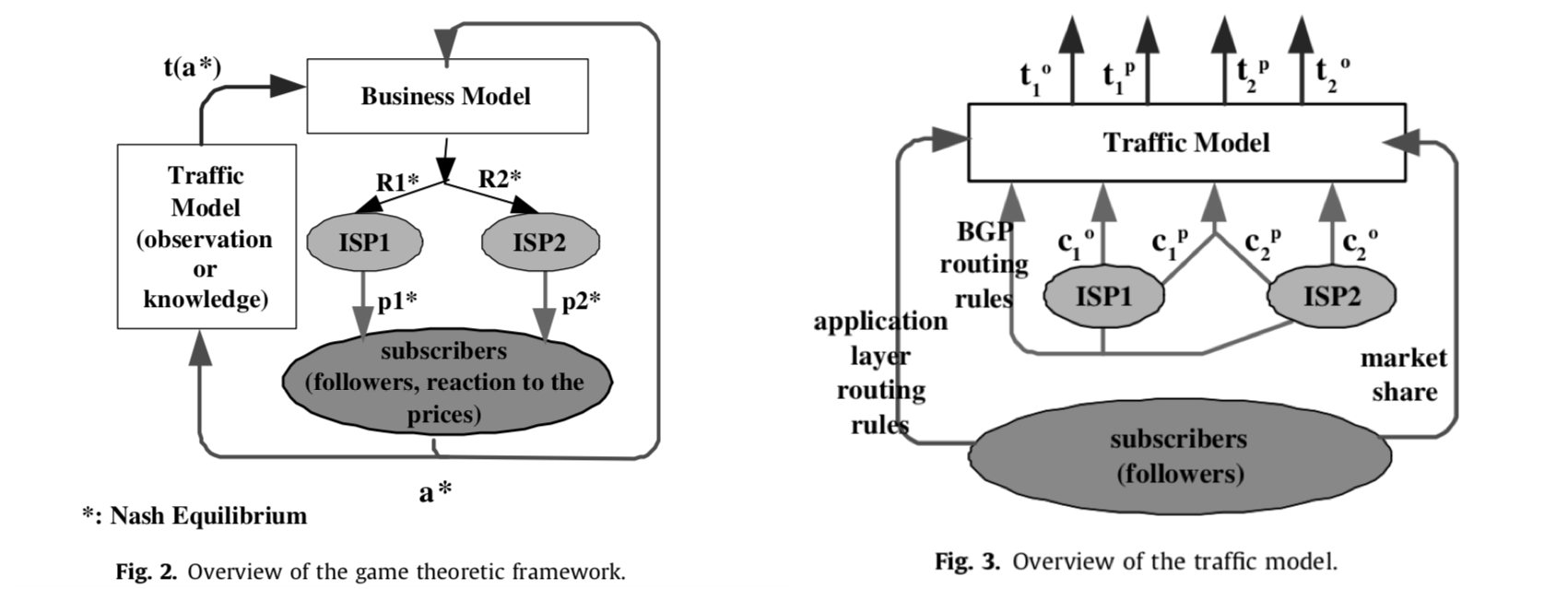
Jessie Hui Wang, Dah Ming Chiu, and John C.S. Lui, "A game–theoretic analysis of the implications of overlay network traffic on ISP peering," CN 2008, Elsevier, Vol.52, No.15, pp. 2961-2974, Oct. 2008. paper Inter-ISP traffic flow determines the settlement between ISPs and affects the perceived performance of ISP services. In today’s Internet, the inter-ISP traffic flow patterns are con- trolled not only by ISPs’ policy-based routing configuration and traffic engineering, but also by application layer routing. The goal of this paper is to study the economic implications of this shift in Internet traffic control assuming rational ISPs and subscribers. For this purpose, we build a general traffic model that predicts traffic patterns based on subscriber distribution and abstract traffic controls such as caching functions and performance sensitivity functions. We also build a game–theoretic model of subscribers picking ISPs, and ISPs making provisioning and peering decisions. In particular, we apply this to a local market where two ISPs compete for market share of subscribers under two traffic patterns: ‘‘Web” and ‘‘P2P overlay”, that typifies the transition the current Internet is going through. Our methodology can be used to quantitatively demonstrate that (1) while economy of scale is the predominant property of the competitive ISP market, P2P traffic may introduce unfair distribution of peering benefit (i.e. free-riding); (2) the large ISP can restore more fairness by reducing its private capacity (bandwidth throttling), which has the drawback of hurting business growth; and (3) ISPs can reduce the level of peering (e.g. by reducing peering bandwidth) to restore more fairness, but this has the side-effect of also reducing the ISPs’ collective bargaining power towards subscribers. |
| [TON 2020] |
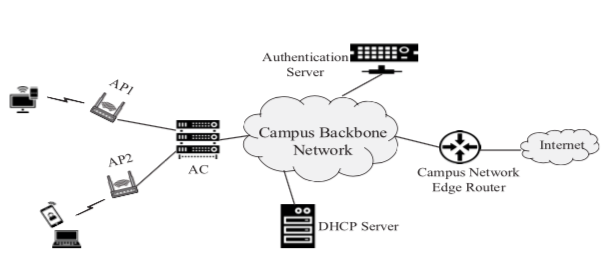
Haibo Wang, Jessie Hui Wang, Jilong Wang, Weizhen Dang, Jing'an Xue, Fenghua Li and Jinzhe Shan, "Squeezing the Gap: An Empirical Study on DHCP Performance in a Large-Scale Wireless Network," IEEE/ACM Transactions on Networking, vol. 28, no. 2, pp. 832 - 845, April 2020. [@IEEE] Dynamic Host Configuration Protocol (DHCP) is widely used to dynamically assign IP addresses to users. However, due to little knowledge on the behavior and performance of DHCP, it is challenging to configure lease time and divide IP addresses for address pools properly in large-scale wireless networks. In this paper, we conduct the largest known measurement on the behavior and performance of DHCP in the wireless network of T University (TWLAN). We find the performance of DHCP is far from satisfactory: (1) The non-authenticated devices lead to a waste of 25% of addresses at the rush hour. (2) Address pool utilization varies greatly under the current address division strategy. (3) A device does not generate traffic for 67% of the lease time on average. Meanwhile, we observe devices of different locations and operating systems show diverse online patterns. To address the problems, taking account of authentication information and online patterns, we propose a new leasing strategy. The results show it outperforms three state-of-the-art baselines and reduces the number of assigned addresses by 24% and the average total lease time by 17% without significantly increasing the DHCP server load. Besides, we further propose an adaptive address division strategy to balance the address utilization of pools. |
| [ICNP 2019] | 
Congcong Miao, Jilong Wang, Tianying Ji, Hui Wang , Chao Xu, Fenghua Li, Fengyuan Ren," BDAC: A Behavior-aware Dynamic Adaptive Configuration on DHCP in Wireless LANs," ICNP 2019. paper DHCP is widely used to dynamically allocate IP addresses to the devices on local area networks, but the explosive increases of WiFi devices and their frequent mobility pose great challenges on DHCP performance in wireless LANs. In this paper, by analyzing large scale real network traces, we observe that the dynamic WiFi user behavior (e.g., online time pattern and spatio-temporal mobility pattern) leads to the poor DHCP performance. The IP pools in some VLANs have been exhausted in rush hours although the total IP utilization in WLAN is only 24%. Therefore, we have to configure IP lease times and IP pools dynamically and make sure that they are adaptive to the WiFi user behavior. In order to achieve this goal, we characterize and model the user behavior across online time pattern and spatio- temporal mobility pattern. Then we propose BDAC, a behavior- aware dynamic adaptive configuration, which is combined of two strategies: adaptive IP lease time configuration and dynamic IP pool configuration. The former is to set adaptive lease times across user roles and area types based on online time pattern to reclaim IP addresses in time and reduce the peak IP usage, while the latter dynamically migrates the IP addresses across VLANs based on spatio-temporal mobility correlation to save the IP addresses. Using the real network traces of a different week, we conduct experiments to evaluate the performance of BDAC. Results show that BDAC can save up to 60% of IP addresses and the actual IP utilization rises from 24% to 59%. Furthermore, BDAC maintains high IP utilization when the number of VLANs in a WLAN increases. |